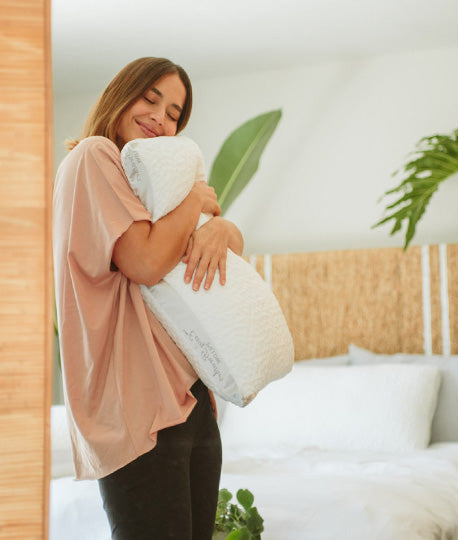Choosing a Mattress For Kids

Parents get a first-hand demonstration -- in the form of irritability or sluggishness -- of how important sleep is to keeping a child healthy and happy. The findings of pediatricians and sleep experts draw even further attention to just how critical sleep is to children and adolescents; sleep deprivation can cause behavior problems, reduced academic performance, and a host of health problems.
In light of this, parents naturally want to do all that they can to promote consistent, high-quality sleep for their children. A fundamental part of achieving that goal is choosing a great mattress for kids. While children can face a number of obstacles to sleep, ensuring that their mattress is comfortable and supportive eliminates one major barrier to meaningful rest on a nightly basis. As an added bonus, building positive sleep habits early in life can reduce the chances of serious sleep problems during adulthood.
When choosing a mattress for kids, there several important factors to consider, including the mattress size, materials, and firmness. In the following sections, we review these and other key topics to help you understand how to find the ideal mattress for your children.
What Size Mattress is Best For Kids?
The ideal mattress size for any child depends on their age and height as well as the amount of space available in their bedroom.
A Twin mattress is the best size for most children and teens. While it’s not exceedingly spacious, it usually provides enough room to move around and find a comfortable sleeping position.
A Twin XL mattress, which has the same width as a Twin but adds five extra inches in length, can be a better match for taller kids. Because growth spurts are unpredictable, especially in adolescent and teenage years, some parents opt for the longer Twin XL to make sure their child doesn’t end up feeling cramped.
A Full mattress, sometimes called a Double, is wider than a Twin or Twin XL, offering extra space for larger children or those who like to really stretch out.
Queen and King mattresses are significantly larger and costlier, and as a result, are rarely the best fit for children.
What Materials Are Best For a Mattress for Kids?
There are many types of mattresses built from different materials, each of which has positives and negatives. In general, the best materials for mattresses for kids are innerspring coils, foam, and latex.
Innerspring coils provide bounce and are temperature neutral, but they can sometimes fall short in providing pressure relief. Foam better cushions the body but sometimes can overheat or have a feel that’s too soft. Latex has plenty of responsiveness with moderate contouring, but it can be heavier and pricier.
Mattresses may use a layered approach with a mix of different materials to optimize the bed’s performance. Regardless of the specific material, parents should focus on finding a mattress with quality components because a well-built bed will offer children the best comfort, support, and durability.
Are Organic Mattresses Better for Kids?
When shopping for a new bed for their kids, many parents are drawn to mattresses that are built with organic materials. Examples of components that may be certified organic include cotton, wool, and latex.
There are several benefits to organic mattresses:
- Chemical-free: At various stages of the process, organic production eliminates potentially harmful chemical inputs. Many parents find peace of mind in knowing that their children are sleeping each night on a product that’s chemical-free.
- Reduced environmental footprint: In most cases, organic production is more sustainable, generating less waste and decreasing a product’s ecological footprint.
- Enhanced attention-to-detail: Receiving organic certification requires that a manufacturer prove their compliance with strict standards. This demands greater attention-to-detail throughout the production process, and that can pay off with a higher-quality mattress.
Some materials, including the majority of mattress foams, are not capable of being certified organic. However, they may have other certifications that demonstrate that they have been tested and verified to be free of compounds or substances that are known to be health risks.
What’s the Right Firmness For a Mattress for Kids?
The right firmness level is subjective since every person has their own comfort preferences. However, most children sleep best with a mattress that falls between Medium Soft (4) and Medium Firm (6) on the firmness scale.
Because children typically weigh less than adults, they don’t usually sink as far into a mattress, which means that they may perceive a mattress to be slightly firmer than an adult would. This difference in perception decreases as children get older and bigger, but it may persist in anyone who has a body weight under 130 pounds.
Children who tend to sleep on their side normally prefer a softer mattress that can fully cushion their shoulders and hips. Back and stomach sleepers frequently need a firmer bed to help maintain their spinal alignment.
Where is the Best Place to Buy a Mattress for Kids?
Parents have options for where to shop, but more and more people are finding that shopping online is the best way to buy a mattress for their kids.
Shopping online offers parents a wide selection, excellent prices and values, and the benefit of taking their time to research their options without a salesperson looking over their shoulder. Free shipping and flexible return policies help eliminate the potential downsides of buying a mattress without seeing it in person first.
Some families may prefer to shop in a brick-and-mortar store where kids can lie down on a few beds to feel them out. If you shop with us, you have the option of starting your search online and then heading to one of our showrooms to test the bed in-person.
But no matter if you’re looking online or in the store, all of our mattresses are perfectly suited to your child.





